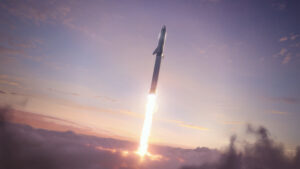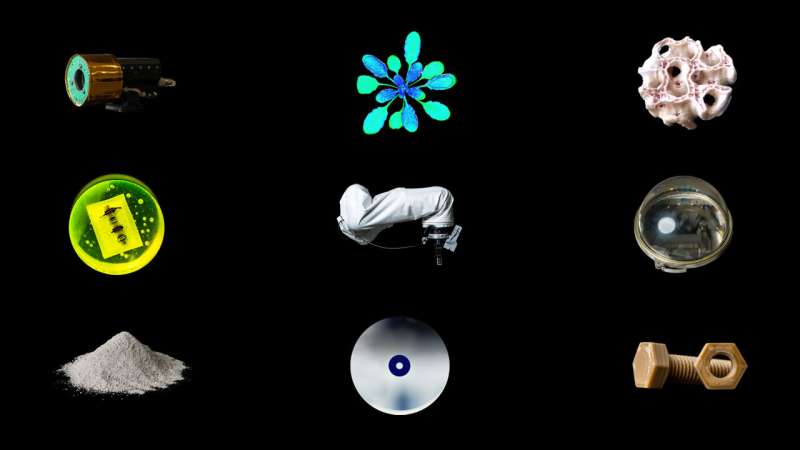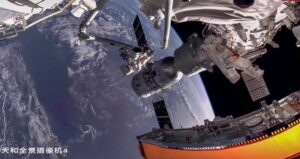An icy spring at the Martian South Pole
Wednesday, 29 December 2021 06:07 In addition to its enormous volcanoes, huge rift valley systems, and dried-up crater lakes and river valleys, the ice caps at the north and south poles of Mars have been the subject of intensive scientific investigations. These ice caps, which grow in the winter and shrink in the spring and summer, are also a distinctly aesthetic sight. This image, created using data acquired by the German Aeros
In addition to its enormous volcanoes, huge rift valley systems, and dried-up crater lakes and river valleys, the ice caps at the north and south poles of Mars have been the subject of intensive scientific investigations. These ice caps, which grow in the winter and shrink in the spring and summer, are also a distinctly aesthetic sight. This image, created using data acquired by the German Aeros FAA delays completion of Starship environmental review
Tuesday, 28 December 2021 22:30
The Federal Aviation Administration says it needs at least two more months to complete an environmental review of SpaceX Starship orbital launches from its Boca Chica, Texas, facility.
99 objects telling tales from ESA's technical heart
Tuesday, 28 December 2021 15:32
From simulated moondust to an ultraflat floor, a 3D-printed human bone to a wall decoration that once flew on the Hubble Space Telescope, the new 99 Objects of ESA ESTEC website gives visitors a close-up view of intriguing, often surprising artifacts assembled together to tell the story of ESA's technical heart.
"Objects are what matter," famed anthropologist Claude Lévi-Strauss once wrote. "Only they carry the evidence that throughout the centuries something really happened among human beings." So what manner of objects come out of more than half a century of activity at Europe's biggest space center?
The European Space Research and Technology Centre, ESTEC, is ESA's singe largest establishment, based on the North Sea coast at Noordwijk in the Netherlands.
Often described as the technical heart of ESA, ESTEC is where most ESA projects are born and where they are guided through the various phases of development.
China’s space station maneuvered to avoid Starlink satellites
Tuesday, 28 December 2021 11:36
China has informed the United Nations that its crewed space station twice maneuvered to avoid potential collisions with SpaceX Starlink satellites earlier this year.
PLD Space closes a Series B investment round of $28 million
Tuesday, 28 December 2021 11:24 PLD Space, the Spanish company that leads the space launch business for small satellites in Europe, has just closed a Series B funding round of $28 million.
The operation, led by Arcano Partners, Aciturri and the Centre for the Development of Industrial Technology (CDTI) through the co-investment initiative of Innvierte program, has had the accompaniment of previous company shareholders, w
PLD Space, the Spanish company that leads the space launch business for small satellites in Europe, has just closed a Series B funding round of $28 million.
The operation, led by Arcano Partners, Aciturri and the Centre for the Development of Industrial Technology (CDTI) through the co-investment initiative of Innvierte program, has had the accompaniment of previous company shareholders, w Visual displays in space station culture
Tuesday, 28 December 2021 11:24 The International Space Station Archaeological Project is the first archaeological study of a human habitat in space. Because of the prohibitive cost of travelling to space, archaeologists have had to think of creative ways to investigate the material culture of the space station. One method is to analyze the thousands of photographs taken of the space station's interior.
Authors Dr. Justi
The International Space Station Archaeological Project is the first archaeological study of a human habitat in space. Because of the prohibitive cost of travelling to space, archaeologists have had to think of creative ways to investigate the material culture of the space station. One method is to analyze the thousands of photographs taken of the space station's interior.
Authors Dr. Justi NASA Builds Artemis III Core Stage Forward Skirt
Tuesday, 28 December 2021 11:24 NASA and Boeing crews have successfully placed the forward skirt for NASA's Space Launch System (SLS) Artemis III rocket into the Vertical Assembly Center robotic weld tool for its next phase of production at NASA's Michoud Assembly Facility in New Orleans.
The forward skirt sits atop the rocket's core stage, and it will be outfitted with the rocket's flight computers and avionics systems
NASA and Boeing crews have successfully placed the forward skirt for NASA's Space Launch System (SLS) Artemis III rocket into the Vertical Assembly Center robotic weld tool for its next phase of production at NASA's Michoud Assembly Facility in New Orleans.
The forward skirt sits atop the rocket's core stage, and it will be outfitted with the rocket's flight computers and avionics systems Virgin Orbit and Arqit expand launch agreements
Tuesday, 28 December 2021 11:24 Virgin Orbit, the responsive launch and space solutions company that has announced a planned business combination with NextGen Acquisition Corp. II, has signed a new launch contract covering two dedicated launches for Arqit Quantum, Inc. a global leader in quantum encryption technology, plus additional commitments.
The two Arqit satellites delivered to Earth orbit by Virgin Orbit's Launche
Virgin Orbit, the responsive launch and space solutions company that has announced a planned business combination with NextGen Acquisition Corp. II, has signed a new launch contract covering two dedicated launches for Arqit Quantum, Inc. a global leader in quantum encryption technology, plus additional commitments.
The two Arqit satellites delivered to Earth orbit by Virgin Orbit's Launche NASA Selects New Members for Artemis Rover Science Team
Tuesday, 28 December 2021 11:24 When NASA's Volatiles Investigating Polar Exploration Rover, or VIPER, explores and samples the soils at the Moon's South Pole, scientists anticipate it will reveal answers to some of the Moon's enduring mysteries. Where is the water and how much is there? Where did the Moon's water come from? What other resources are there?
What other questions could VIPER answer? NASA sought ideas and re
When NASA's Volatiles Investigating Polar Exploration Rover, or VIPER, explores and samples the soils at the Moon's South Pole, scientists anticipate it will reveal answers to some of the Moon's enduring mysteries. Where is the water and how much is there? Where did the Moon's water come from? What other resources are there?
What other questions could VIPER answer? NASA sought ideas and re Earth and Mars were formed from inner Solar System material
Tuesday, 28 December 2021 11:24 Earth and Mars were formed from material that largely originated in the inner Solar System; only a few percent of the building blocks of these two planets originated beyond Jupiter's orbit. A group of researchers led by the University of Munster (Germany) report these findings in the journal "Science Advances".
They present the most comprehensive comparison to date of the isotopic composit
Earth and Mars were formed from material that largely originated in the inner Solar System; only a few percent of the building blocks of these two planets originated beyond Jupiter's orbit. A group of researchers led by the University of Munster (Germany) report these findings in the journal "Science Advances".
They present the most comprehensive comparison to date of the isotopic composit Billions of starless planets haunt dark cloud cradles
Tuesday, 28 December 2021 11:24 In Lovecraftian horror, the Universe is filled with "dark planets" ungraced by the light of a host star. New research shows that reality might be even scarier. An international team composed of French, Japanese, and Spanish astronomers has found about 100 planets floating freely in space rather than orbiting stars. Extrapolating this sample to the rest of the Milky Way Galaxy suggests that there
In Lovecraftian horror, the Universe is filled with "dark planets" ungraced by the light of a host star. New research shows that reality might be even scarier. An international team composed of French, Japanese, and Spanish astronomers has found about 100 planets floating freely in space rather than orbiting stars. Extrapolating this sample to the rest of the Milky Way Galaxy suggests that there ESO telescopes help uncover largest group of rogue planets yet
Tuesday, 28 December 2021 11:24 "We did not know how many to expect and are excited to have found so many," says Nuria Miret-Roig, an astronomer at the Laboratoire d'Astrophysique de Bordeaux, France and the University of Vienna, Austria, and the first author of the new study published in Nature Astronomy.
Rogue planets, lurking far away from any star illuminating them, would normally be impossible to image. However, Mir
"We did not know how many to expect and are excited to have found so many," says Nuria Miret-Roig, an astronomer at the Laboratoire d'Astrophysique de Bordeaux, France and the University of Vienna, Austria, and the first author of the new study published in Nature Astronomy.
Rogue planets, lurking far away from any star illuminating them, would normally be impossible to image. However, Mir Astronomers Detect Signature of Magnetic Field on an Exoplanet
Tuesday, 28 December 2021 11:24 An international team of astronomers used data from the Hubble Space Telescope to discover the signature of a magnetic field in a planet outside our solar system. The finding, described in a paper in the journal Nature Astronomy, marks the first time such a feature has been seen on an exoplanet.
A magnetic field best explains the observations of an extended region of charged carbon particl
An international team of astronomers used data from the Hubble Space Telescope to discover the signature of a magnetic field in a planet outside our solar system. The finding, described in a paper in the journal Nature Astronomy, marks the first time such a feature has been seen on an exoplanet.
A magnetic field best explains the observations of an extended region of charged carbon particl Wandering celestial bodies provide a glimpse into the formation of stars and planets
Tuesday, 28 December 2021 11:24 The nature of free-floating planets (FFPs) is still mysterious. FFPs might originate in two ways: they either form on their own, like stars, through the gravitational collapse of small clouds of gas, or they form like planets around stars and then get stripped off from their stellar systems. Until now it was hard to investigate which formation mechanism is more likely, as a large homogenous samp
The nature of free-floating planets (FFPs) is still mysterious. FFPs might originate in two ways: they either form on their own, like stars, through the gravitational collapse of small clouds of gas, or they form like planets around stars and then get stripped off from their stellar systems. Until now it was hard to investigate which formation mechanism is more likely, as a large homogenous samp Tracking down the forces that shaped our solar system's evolution
Tuesday, 28 December 2021 11:24 Meteorites are remnants of the building blocks that formed Earth and the other planets orbiting our Sun. Recent analysis of their isotopic makeup led by Carnegie's Nicole Nie and published in Science Advances settles a longstanding debate about the geochemical evolution of our Solar System and our home planet.
In their youth, stars are surrounded by a rotating disk of gas and dust. Over ti
Meteorites are remnants of the building blocks that formed Earth and the other planets orbiting our Sun. Recent analysis of their isotopic makeup led by Carnegie's Nicole Nie and published in Science Advances settles a longstanding debate about the geochemical evolution of our Solar System and our home planet.
In their youth, stars are surrounded by a rotating disk of gas and dust. Over ti 